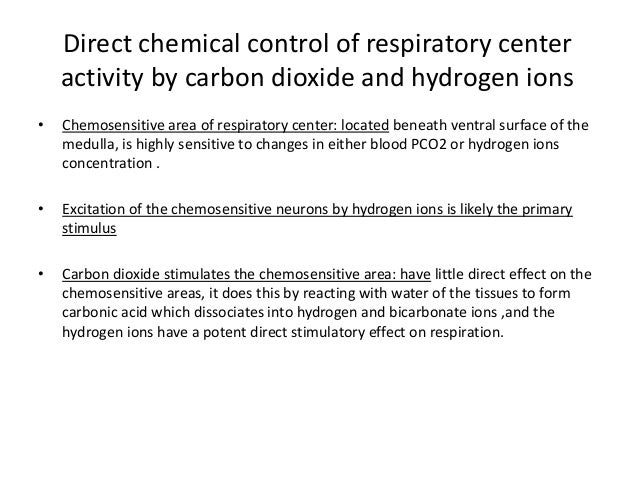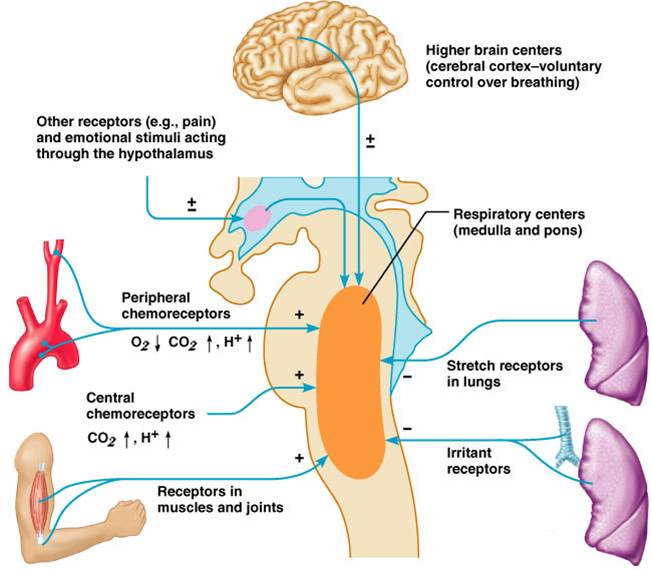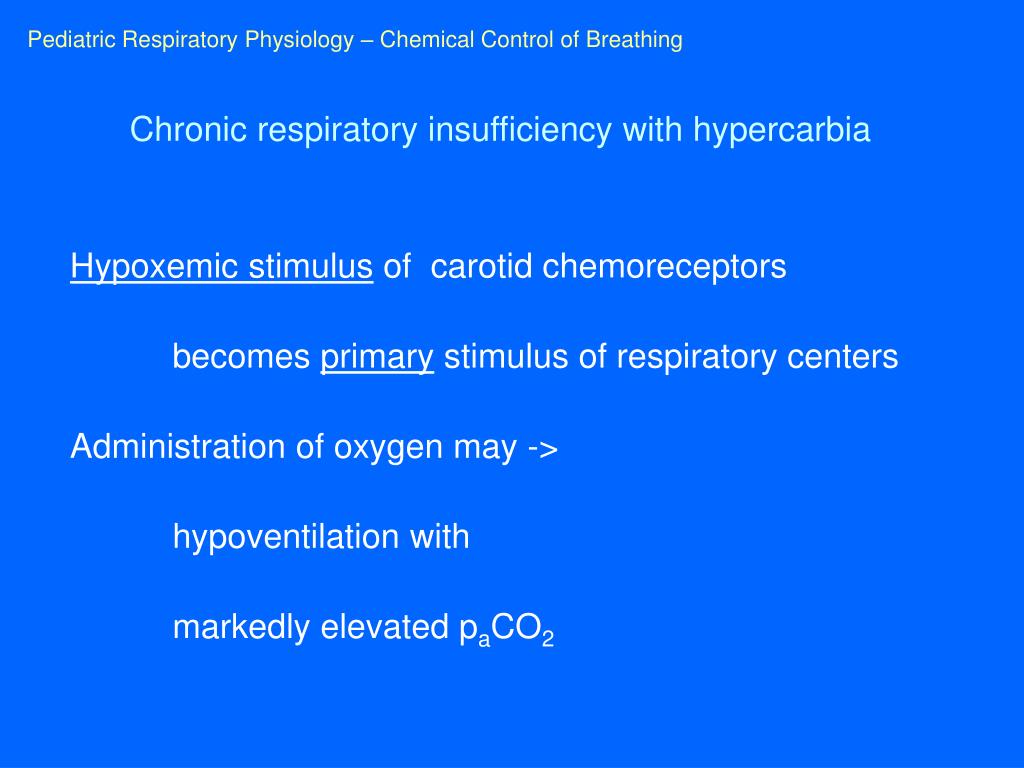What Is the Primary Stimulus for Ventilation
Hypercapnia and shift of normal respiratory drive to hypoxic drive to maintain respiratory hemostasis 1011. It provides the main stimulus for inspiration.

Ch 22 The Respiration System Ppt Download
Here it continues distally to the carina then through the primary bronchi various branches of bronchioles and eventually arriving in the alveoli.

. Essay answers are limited to about 500 words 3800 characters maximum including spaces. In addition this region is the recipient of important afferent stimuli most notably from peripheral and central chemoreceptors and from receptors in the lung. It consists mainly of inspiratory neurons.
These neurons are involved in the hering breuer and heads. Describe how carbon dioxide pH and oxygen are related to the regulation of ventilation. The most important stimulus for regulation of ventilation in healthy persons is increased levels of carbon dioxide.
The primary direct stimulus for excitation of central chemoreceptors regulating ventilation is. These neurons project contralaterally to the phrenic and intercostal motor neurons in the spinal cord and provide the primary stimulus for respiration. There are two primary types of thoracic sensors.
However despite the long. This is an important point to remember as it is not unusual for patients on. What is the strongest stimulus that causes an increase in ventilation through the chemoreceptor reflex.
The initiation of ventilation begins with the brainstem where impulses action potentials generate within the medulla oblongata then travel distally within the spinal cord. Mechanoreceptors found in the airways trachea lung and pulmonary vessels provide sensory information to the respiratory center in the brain with regards to lung volume airway stretch and vascular congestion. Essay answers are limited to about 500.
Central chemoreceptors Carbon dioxide is one of the most powerful stimulants of breathing. Slow adapting stretch spindles and rapid adapting irritant receptors. As such this tight regulation of ventilation to metabolic rate ensures the homeostasis of the arterial partial pressure of oxygen P a O 2 carbon dioxide P a CO 2 and pH.
Increased levels of carbon dioxide and decreased blood pH are the most important stimuli leading to an increase in the rate and depth of breathing. Describe the location and chemical sensitivity of the different respiratory chemoreceptors 31. As the partial pressure of carbon dioxide in arterial blood rises ventilation increases nearly linearly.
An increase in carbon dioxide increases. Any one of a group of experimental stimulants which are to be compared to a constant stimulant step-by-step. Tap card to see definition.
Air movement in a reverse pathway from alveoli to mouth and nose is exhalation. What is the primary stimulus for breathing. During submaximal steady-state exercise increases in ventilation are proportional to the increase in carbon dioxide production V co 2 and oxygen consumption V o 2.
During very short-term bouts of intense exercise the release of lactic acid into the blood by the exercising muscles causes a fall in the blood plasma pH independently of the rise in the PCO2 and this will stimulate pulmonary ventilation sufficiently to keep the blood pH constant at the expense of a lowered PCO2. See answer 1 Best Answer. What is the most important stimulus in the control of ventilation.
Carbon dioxide is one of the most powerful stimulants of breathing. This is referred to as a hypoxic drive. Click card to see definition.
This system though slower than the peripheral chemoreceptors is the primary stimulus of ventilation and is estimated to provide 80 of the stimulus for a. What is the primary stimulus for breathing hypoxia. In normal circumstances our primary stimulus to breaths is PaCO 2.
It sends impulses to the phrenic and external intercostal motor in the spinal cord. Is the primary stimulant for ventilation in healthy persons while hypoxia. Inhalation followed by exhalation equals one ventilation.
Which of the following statements are true of the dorsal respiratory group DRG. Because of the desensitization of the central chemoreceptors the peripheral chemoreceptors become the primary stimulus to control ventilation. Although many factors can modify respiratory rate and depth the most important factors are chemical - the levels of carbon dioxide and oxygen in the blood.
As the partial pressure of carbon dioxide in arterial blood rises ventilation increases nearly linearly. What is the strongest stimulus that causes an increase in ventilation through the chemoreceptor reflex. Decreased CO2 3Increased H 4.
D ventilation would be unaffected since the respiratory centers are safely located in the brain complete diaphragmatic paralysis would result and the patient would require mechanical ventilation What is the most powerful stimulus of the medullary respiratory centers. Thus hypoxia rather than CO 2 becomes the stimulus for the person to breathe. 2012-11-01 22.
Describe the relationship between carbon dioxide hemoglobin and oxygen. Even if both the carotid and aortic bodies are removed inhaling gases that contain carbon dioxide stimulates breathing. Carbon dioxide is the main stimulus for the respiratory drive in normal physiological states.
Psychology Definition of VARIABLE STIMULUS. Options is. Describe the chloride shift.

What Is The Primary Stimulus For Breathing

What Is The Primary Stimulus For Breathing

What Is The Primary Stimulus For Breathing

What Is The Primary Stimulus For Breathing

What Is The Primary Stimulus For Breathing

Primary Stimulus For Breathing

O X Y G E N By Patrick Mckeown Addressing Dysfunctional Breathing In Athletes And Simulating High Altitude Training To Improve Aerobic And Anaerobic Performance Ppt Download

Respiratory System Cellular Respiration Most Cells Utilize Cellular

0 Response to "What Is the Primary Stimulus for Ventilation"
Post a Comment